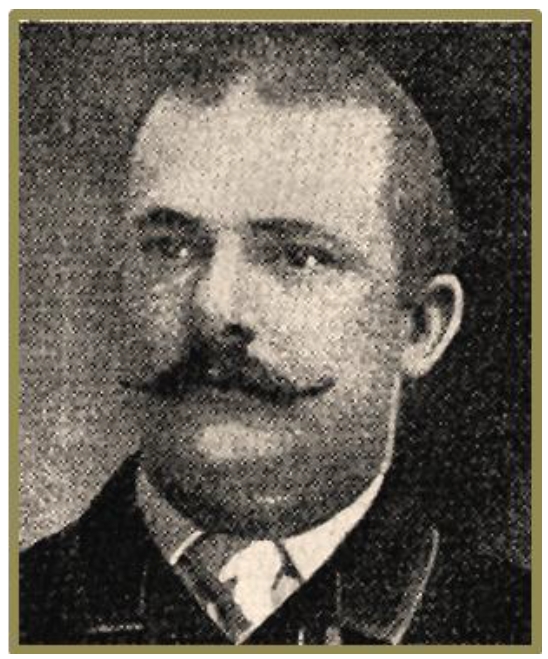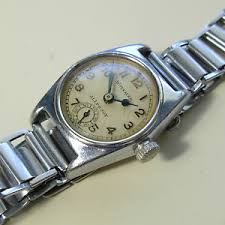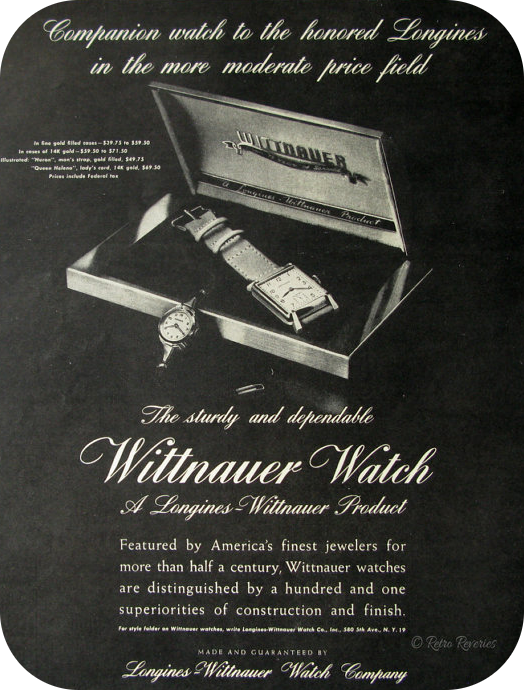The History Of The Wittnauer Watch Company
A young man, Albert Wittnauer, had a dream of creating a durable watch which eventually he realized and evolved the brand into his name being found on the wrists of United States astronauts, pilots, actors and all types of people found throughout the world. Albert had an uncle, Eugene Robert, who was a successful importer of watches. Robert focused mostly on high end pieces such as Vacheron & Constantin and Jaeger LeCoultre. Robert and his sales outlet operated a successful business out of New York and things were going so well for himself that he decided to hire his 16 year old Swiss immigrant brother-in-law, Albert Wittnauer, who at 16 years old was already a highly skilled watchmaker, to help.
Eventually Albert became more involved in things which helped immensely and as he grew older Albert saw in his mind the real potential in the industry of watches and with the help of his family he decided there was a need for a watch that would be designed for durability and function that, in his mind, he felt the American people were missing. Albert was looking to create an affordable Swiss watch that was of higher quality despite having a lower price. A tall order for any brand of watches, but he was young and determined.
When Albert was 24 his vision began to really get going, the company began as a small family business and the first watch line that Wittnauer designed was in the year 1880, after 5 additional years he finally decided to formally establish the Wittnauer watch brand. Robert and Wittnauer decided to title the company under the name A. Wittnauer company as Robert was now the exclusive sales agent for the Swiss luxury brand Longines in America and focused most of his energy towards that.
Albert had two of his brothers join him to help handle the company growth as Louis and Emile joined Albert from Switzerland. The Wittnauer family initially outsourced their movements by the Swiss contacts they had formed from people found within their homeland. The company was now located on the tenth floor of a new fourteen-story skyscraper at 9-13 Maiden Lane, which was in the center of New York’s jewelry and watchmaking industry at the time.

Albert had a keen eye and hired two important gentleman; Ferdinand Haschka and Charles Johns. Haschka had completed an apprenticeship at the German Watchmaker School ‘Glashütte’ and worked with Wittnauer many years until he eventually became the chief watch maker at Tiffany & Co. leading the watch department there. Haschka was also a member and one of the founders of the Horological Institute of America. His books on the subject are in located at the United States National Museum. Johns was so talented he personally developed a perpetual calendar chronometer watch that would be featured at the 1939 World’s fair in New York.
The Wittnauer company had early customers that were in the field of navigators, explorers and even astronomers. The fans they had created really loved the reliability of their watches. Things continued to grow as the Wittnauer company became further involved with the U.S. Navy while helping in the fields of both aviation and navigation. Their positive reputation continued to evolve and they grew marketing navigational timepieces.
In 1899, the two brothers lost Louis as he died at the age of 41 which left Albert and Emile to direct the company without him. However, the company continued to move forward as the Wittnauer company moved to New York Center and soon after decided to acquire a production plant on the island of Puerto Rico. Albert died at age 52, in 1908, and Emile took control of the company for the next seven years until passing away also in 1915. When the last Wittnauer brother died, very little women were in authoritative positions however their sister Martha Wittnauer became the first woman watch brand CEO. Despite her lack of formal business training, Martha would lead the company for more than twenty years, surviving both a World War and the Great Depression. Martha was a compassionate boss who provided security to her staff, some of who remained at the company for upwards of 35 years. She was the first woman to be elected into the Horlogical Society of America. Martha continued working with the United States military and produced many instruments and watches for the early aviation units.

In 1918 the company branded the Wittnauer AllProof which was the first waterproof (a term that is no longer accepted), shock proof, anti magnetic all proof watch that was used by Jimmie Mattern, an American pilot, who had twice attempted to circumnavigate the world, and it was he that praised his Wittnauer for surviving his crash landing. Neil Armstrong also used the Wittnauer watch to honor Jimmie, wearing the watch during the Gemini 8 mission. In 1926, Americas first radio network, NBC selected Wittnauer to provide official timing for its radio broadcasting. On May 20–21, 1932 Amelia Earhart made the first solo flight across the Atlantic with her Lockheed Vega-5B equipped with Wittnauer instruments. Wittnauer products were widely used in scientific expeditions and exploration, and was one of three contenders for the first mission on the moon along with Omega Speedmaster and Rolex Daytona. (The honor went to Omega) By 1934, Wittnauer was now operating on Fifth Avenue in New York.
In 1936, in the middle of the depression, the sale of luxury items was suffering and Martha decides to sell A. Wittnauer company to Hella Deltah Company, a successful pearl manufacturer. The sale would ensure the survival and success of the company. Capitalizing on the long partnership and history with Longines, the company was renamed Longines-Wittnauer. Both brands produced distinctly different movements, though both were of similar excellent quality. The ownership would continue this way until 1969.
In 1941 as America entered the War, Wittnauer, because of its long relationship with the U.S. military, received contracts to produce compasses, laboratory timers, aircraft clocks and military watches. The company’s repair center also offered employment to many skilled watchmakers who were forced to flee war ravished Europe. With domestic watch production diverted, Swiss watches gained on the consumer market. While all their assembly and repair facilities were devoted to the war effort, the Wittnauer assembly line had worked overtime to produce watches for the domestic market with movements imported from neutral country Switzerland.
In 1949 Wittnauer continued to innovate and in 1949 they introduced an accurate self-winding watch that is slimmer, yet more durable, than previous self-winding models that were available. Eight years later, Wittnauer unveiled their first electric watch.
In 1969, the Westinghouse Electric Corporation purchased Wittnauer, bringing together an electrical industry giant, who was once a rival to Thomas Edison’s electric company, and the Wittnauer brand at the forefront of the newest electronic timekeeping technology.

In 1972, Robert Pliskin was installed as president and he dedicated himself to improving and increasing the quality of the company offerings, concentrating on the Wittnauer watch brands, as well as Atmos clocks ( the mechanical torsion pendulum clock ), while continuing to refine its electronic watch innovations. While president, he boosted the company’s sales 79%-from $28 million to $50 million-in less then seven years.
1979 John L. Davis, an active and innovative sales executive for the preceding 34 years, becomes president of Wittnauer. Davis continues to update and refine the company’s products, bringing it firmly into the electronic age with improved quartz analog watches. He would stay with the company as president until 1991.
In 1983, Longines becomes part of the Société Swiss de Microélectronique et D’Horlogerie, now known as The Swatch Group. Longines is still a thriving brand within The Swatch Group today. This move would effect Wittnauer-Longines later on.
1991 With the revived slogan, “The Watchmaker’s Watch,” the Wittnauer watch brand becomes the primary focus of the company. New company president, Reynald M. Swift, hires a new advertising agency specifically for Wittnauer watches. Swift chose Henry Fried, the Dean of the watch industry, to put together a major book project covering the companies complete story. This comprehensive definitive volume was made available to all Longines-Wittnauer jewelers.
In 1994, The Swatch Group decided to take over the entire distribution of Longines in the U.S., and with this decision their more than a century association with Wittnauer ended. Longines-Wittnauer renamed their company Wittnauer International Inc. and focused all energy on the Wittnauer brand.
In 1996, president Swift along with 3 other executives from Wittnauer, backed by the Composite Resources LLC, bought the rights to the company from Westinghouse Electric for 28 million dollars. Robert L. Coleman and Charles D. Watkins of Composite Resources, from St. Louis, outbid Movado and Bulova to gain control of the brand. Mr. Coleman earned an M.B.A. from Stanford University in Palo Alto, CA. Mr. Watkins earned a master’s degree in public affairs from Washington University in St. Louis. The four executives later sold their shares and left Wittnauer. Coleman was now the acting CEO of Wittnauer while Watkins was president. Wittnauer, the brand that had the first woman CEO in watch history, now had the first two African-American president and CEO serving at the same brand in watch history, as well. The two remaining entrepreneurs were a successful team and Coleman and Watkins pushed the brand forward for the next 5 years reaching distribution of 300,000 timepieces a year while employing 176 employees in the United States, Canada and Puerto Rico. Eventually there were some budget problems, and the company needed to sell some or all or it’s assets to offload cumulative debt that had occured.

This allowed Bulova to realize their earlier attempt and acquire all Wittnauer trademarks, related inventory and receivables, and some equipment from the former Wittnauer International (now the name for Bulova’s division) for $11.6 million in September. Wittnauer now continues to be a brand of high-quality, Swiss watches, with the added benefit of Bulova’s strengths in financial management, distribution, and service. The Swiss brand complements Bulova’s three other brands making the Bulova core – Bulova, Wittnauer, Accutron, and Caravelle.
Times Ticking has been in operation for more than 30 years, since 1982. We have performed watch repair for customers both locally and internationally. If it Ticks! We KNOW it! Our team of watch repair technicians have a combined experience in watchmaking of over 120 years.

